机械工程英语第二版第二部分完整翻译(叶邦彦、陈统坚主编)教学提纲
- 格式:pdf
- 大小:26.80 MB
- 文档页数:115
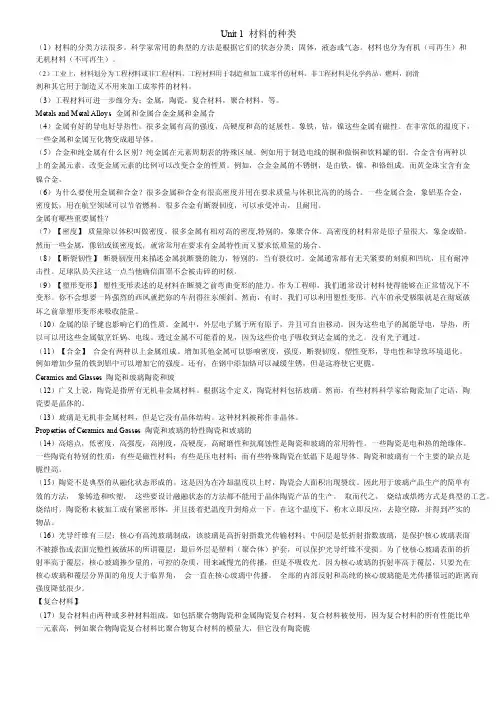
Unit 1 材料的种类(1)材料的分类方法很多。
科学家常用的典型的方法是根据它们的状态分类:固体,液态或气态。
材料也分为有机(可再生)和无机材料(不可再生)。
(2)工业上,材料划分为工程材料或非工程材料。
工程材料用于制造和加工成零件的材料。
非工程材料是化学药品,燃料,润滑剂和其它用于制造又不用来加工成零件的材料。
(3)工程材料可进一步细分为:金属,陶瓷,复合材料,聚合材料,等。
Metals and Metal Alloys 金属和金属合金金属和金属合(4)金属有好的导电好导热性,很多金属有高的强度,高硬度和高的延展性。
象铁,钴,镍这些金属有磁性。
在非常低的温度下,一些金属和金属互化物变成超导体。
(5)合金和纯金属有什么区别?纯金属在元素周期表的特殊区域。
例如用于制造电线的铜和做锅和饮料罐的铝。
合金含有两种以上的金属元素。
改变金属元素的比例可以改变合金的性质。
例如,合金金属的不锈钢,是由铁,镍,和铬组成。
而黄金珠宝含有金镍合金。
(6)为什么要使用金属和合金?很多金属和合金有很高密度并用在要求质量与体积比高的的场合。
一些金属合金,象铝基合金,密度低,用在航空领域可以节省燃料。
很多合金有断裂韧度,可以承受冲击,且耐用。
金属有哪些重要属性?(7)【密度】质量除以体积叫做密度。
很多金属有相对高的密度,特别的,象聚合体。
高密度的材料常是原子量很大,象金或铅。
然而一些金属,像铝或镁密度低,就常常用在要求有金属特性而又要求低质量的场合。
(8)【断裂韧性】断裂韧度用来描述金属抗断裂的能力,特别的,当有裂纹时。
金属通常都有无关紧要的刻痕和凹坑,且有耐冲击性。
足球队员关注这一点当他确信面罩不会被击碎的时候。
(9)【塑形变形】塑性变形表述的是材料在断裂之前弯曲变形的能力。
作为工程师,我们通常设计材料使得能够在正常情况下不变形。
你不会想要一阵强烈的西风就把你的车刮得往东倾斜。
然而,有时,我们可以利用塑性变形。
汽车的承受极限就是在彻底破坏之前靠塑形变形来吸收能量。
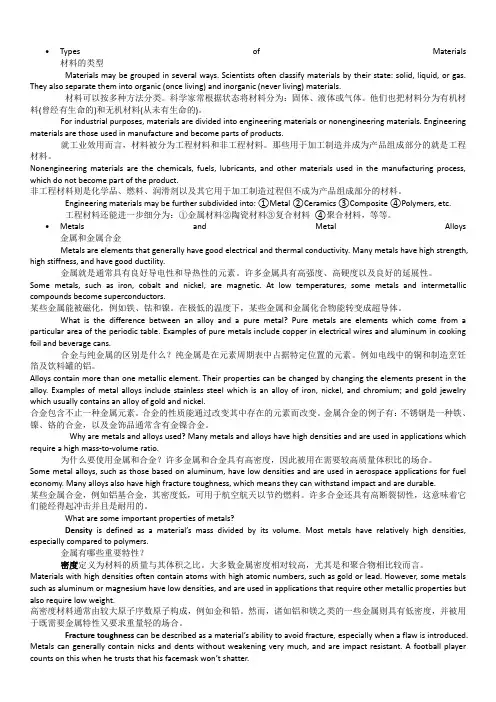
•Types of Materials 材料的类型Materials may be grouped in several ways. Scientists often classify materials by their state: solid, liquid, or gas. They also separate them into organic (once living) and inorganic (never living) materials.材料可以按多种方法分类。
科学家常根据状态将材料分为:固体、液体或气体。
他们也把材料分为有机材料(曾经有生命的)和无机材料(从未有生命的)。
For industrial purposes, materials are divided into engineering materials or nonengineering materials. Engineering materials are those used in manufacture and become parts of products.就工业效用而言,材料被分为工程材料和非工程材料。
那些用于加工制造并成为产品组成部分的就是工程材料。
Nonengineering materials are the chemicals, fuels, lubricants, and other materials used in the manufacturing process, which do not become part of the product.非工程材料则是化学品、燃料、润滑剂以及其它用于加工制造过程但不成为产品组成部分的材料。
Engineering materials may be further subdivided into: ①Metal ②Ceramics ③Composite ④Polymers, etc.工程材料还能进一步细分为:①金属材料②陶瓷材料③复合材料④聚合材料,等等。
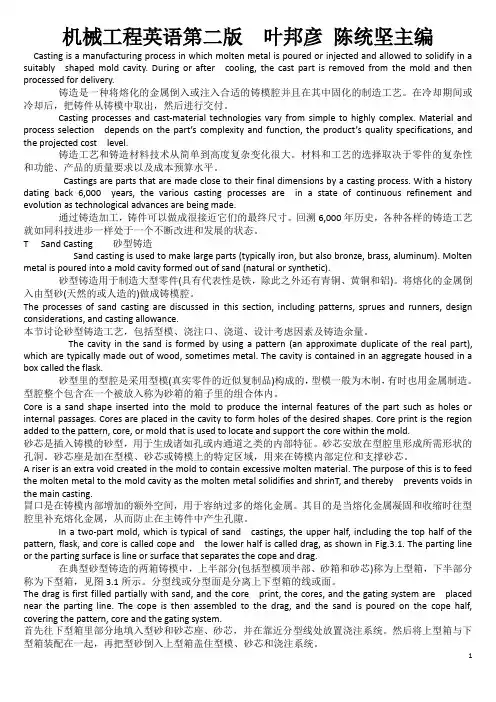
机械工程英语第二版叶邦彦陈统坚主编Casting is a manufacturing process in which molten metal is poured or injected and allowed to solidify in a suitably shaped mold cavity. During or after cooling, the cast part is removed from the mold and then processed for delivery.铸造是一种将熔化的金属倒入或注入合适的铸模腔并且在其中固化的制造工艺。
在冷却期间或冷却后,把铸件从铸模中取出,然后进行交付。
Casting processes and cast-material technologies vary from simple to highly complex. Material and process selection depends on the part’s complexity and function, the product’s quality specifications, and the projected cost level.铸造工艺和铸造材料技术从简单到高度复杂变化很大。
材料和工艺的选择取决于零件的复杂性和功能、产品的质量要求以及成本预算水平。
Castings are parts that are made close to their final dimensions by a casting process. With a history dating back 6,000 years, the various casting processes are in a state of continuous refinement and evolution as technological advances are being made.通过铸造加工,铸件可以做成很接近它们的最终尺寸。
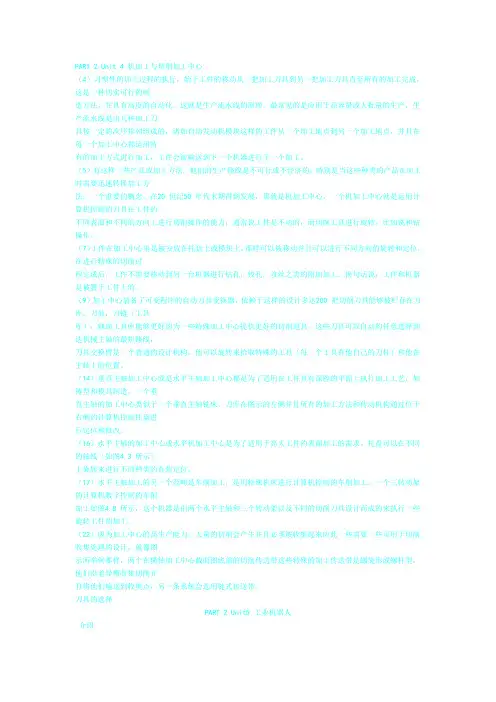
PART 2 Unit 4 机加工与切削加工中心(4)习惯性的加工过程的执行,始于工件的移动从一把加工刀具到另一把加工刀具直至所有的加工完成,这是一种切实可行的制造方法,并具有高度的自动化。
这就是生产流水线的原理。
最常见的是应用于高容量或大批量的生产,生产流水线是由几种加工刀具按一定的次序排列组成的,诸如自动发动机模块这样的工件从一个加工地点到另一个加工地点,并且在每一个加工中心都运用特有的加工方式进行加工,工件会被输送到下一个机器进行下一个加工。
(5)有这样一些产品或加工方法,他们的生产路线是不可行或不经济的,特别是当这些种类的产品在加工时需要迅速转换加工方法。
一个重要的概念,在20 世纪50 年代末期得到发展,那就是机加工中心。
一个机加工中心就是运用计算机控制的刀具在工件的不同表面和不同的方向上进行切削操作的能力,通常说工件是不动的,而切削工具进行旋转,比如铣和钻操作。
(7)工件在加工中心里是被安放在托盘上或模块上,那样可以被移动并且可以进行不同方向的旋转和定位,在进行特殊的切削过程完成后,工件不需要移动到另一台机器进行钻孔,铰孔,攻丝之类的附加加工。
换句话说,工件和机器是被置于工件上的。
(9)加工中心装备了可变程序的自动刀具变换器,依赖于这样的设计多达200 把切削刀具能够被贮存在刀库,刀鼓,刀链(工具库),辅助工具库能够更好的为一些特殊加工中心提供更好的切削道具,这些刀具可以自动的任意选择到达机械主轴的最短路线,刀具交换臂是一个普通的设计机构,他可以旋转来拾取特殊的工具(每一个工具有他自己的刀杆)和他在主轴上的位置。
(14)垂直主轴加工中心或是水平主轴加工中心都是为了适用在工件具有深腔的平面上执行加工工艺,如铸型和模具制造。
一个垂直主轴的加工中心类似于一个垂直主轴铣床。
刀库在图示的左侧并且所有的加工方法和传动机构通过位于右侧的计算机控制托盘进行定位和修改。
(16)水平主轴的加工中心或水平机加工中心是为了适用于高大工件的表面加工的需求。
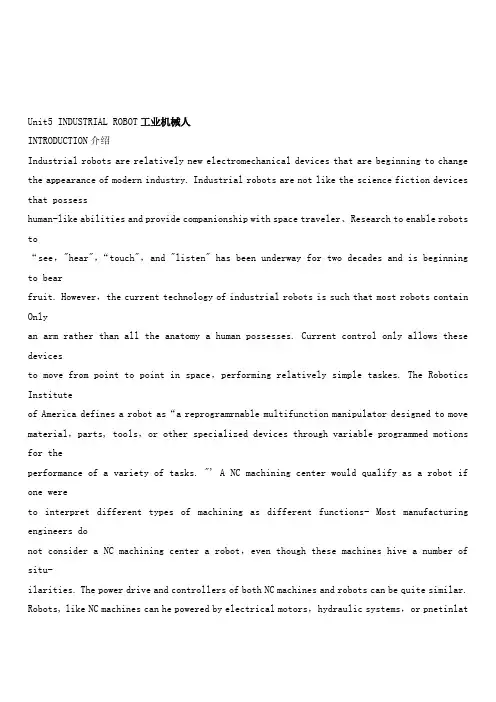
Unit5 INDUSTRIAL ROBOT工业机械人INTRODUCTION介绍Industrial robots are relatively new electromechanical devices that are beginning to change the appearance of modern industry. Industrial robots are not like the science fiction devices that possesshuman-like abilities and provide companionship with space traveler、Research to enable robots to“see,"hear",“touch",and "listen" has been underway for two decades and is beginning to bearfruit. However,the current technology of industrial robots is such that most robots contain Onlyan arm rather than all the anatomy a human possesses. Current control only allows these devicesto move from point to point in space,performing relatively simple taskes. The Robotics Instituteof America defines a robot as“a reprogram rnable multifunction manipulator designed to move material,parts, tools,or other specialized devices through variable programmed motions for theperformance of a variety of tasks. "' A NC machining center would qualify as a robot if one wereto interpret different types of machining as different functions- Most manufacturing engineers donot consider a NC machining center a robot,even though these machines hive a number of situ-ilarities. The power drive and controllers of both NC machines and robots can be quite similar. Robots, like NC machines can he powered by electrical motors,hydraulic systems,or pnetinlat。
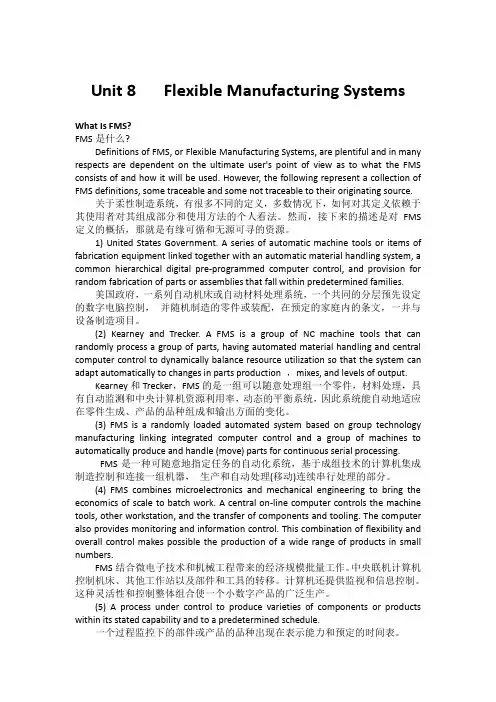
Unit 8 Flexible Manufacturing Systems What Is FMS?FMS是什么?Definitions of FMS, or Flexible Manufacturing Systems, are plentiful and in many respects are dependent on the ultimate user's point of view as to what the FMS consists of and how it will be used. However, the following represent a collection of FMS definitions, some traceable and some not traceable to their originating source.关于柔性制造系统,有很多不同的定义,多数情况下,如何对其定义依赖于其使用者对其组成部分和使用方法的个人看法。
然而,接下来的描述是对FMS 定义的概括,那就是有缘可循和无源可寻的资源。
1) United States Government. A series of automatic machine tools or items of fabrication equipment linked together with an automatic material handling system, a common hierarchical digital pre-programmed computer control, and provision for random fabrication of parts or assemblies that fall within predetermined families.美国政府,一系列自动机床或自动材料处理系统,一个共同的分层预先设定的数字电脑控制,并随机制造的零件或装配,在预定的家庭内的条文,一并与设备制造项目。
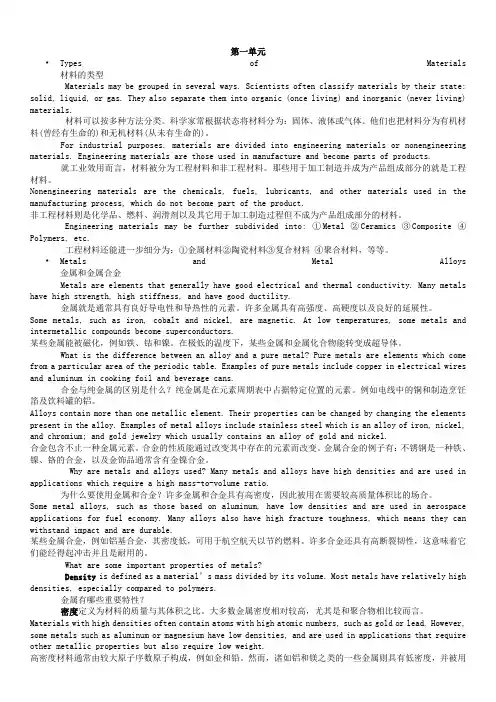
第一单元•Types of Materials 材料的类型Materials may be grouped in several ways. Scientists often classify materials by their state: solid, liquid, or gas. They also separate them into organic (once living) and inorganic (never living) materials.材料可以按多种方法分类。
科学家常根据状态将材料分为:固体、液体或气体。
他们也把材料分为有机材料(曾经有生命的)和无机材料(从未有生命的)。
For industrial purposes, materials are divided into engineering materials or nonengineering materials. Engineering materials are those used in manufacture and become parts of products.就工业效用而言,材料被分为工程材料和非工程材料。
那些用于加工制造并成为产品组成部分的就是工程材料。
Nonengineering materials are the chemicals, fuels, lubricants, and other materials used in the manufacturing process, which do not become part of the product.非工程材料则是化学品、燃料、润滑剂以及其它用于加工制造过程但不成为产品组成部分的材料。
Engineering materials may be further subdivided into: ①Metal ②Ceramics ③Composite ④Polymers, etc.工程材料还能进一步细分为:①金属材料②陶瓷材料③复合材料④聚合材料,等等。
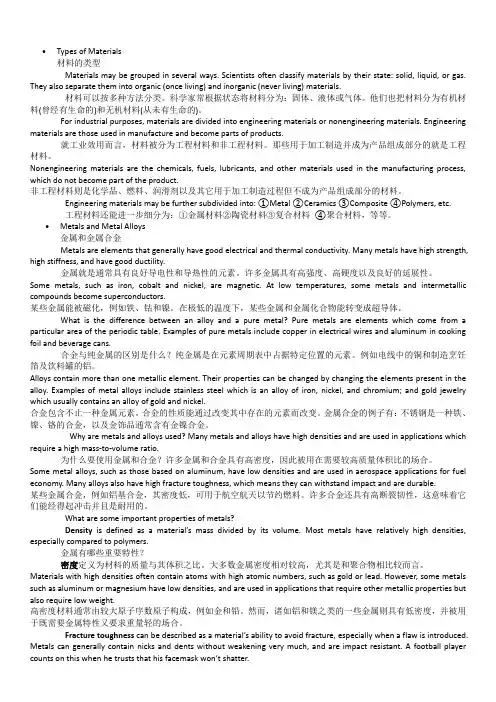
•Types of Materials材料的类型Materials may be grouped in several ways. Scientists often classify materials by their state: solid, liquid, or gas. They also separate them into organic (once living) and inorganic (never living) materials.材料可以按多种方法分类。
科学家常根据状态将材料分为:固体、液体或气体。
他们也把材料分为有机材料(曾经有生命的)和无机材料(从未有生命的)。
For industrial purposes, materials are divided into engineering materials or nonengineering materials. Engineering materials are those used in manufacture and become parts of products.就工业效用而言,材料被分为工程材料和非工程材料。
那些用于加工制造并成为产品组成部分的就是工程材料。
Nonengineering materials are the chemicals, fuels, lubricants, and other materials used in the manufacturing process, which do not become part of the product.非工程材料则是化学品、燃料、润滑剂以及其它用于加工制造过程但不成为产品组成部分的材料。
Engineering materials may be further subdivided into: ①Metal ②Ceramics ③Composite ④Polymers, etc.工程材料还能进一步细分为:①金属材料②陶瓷材料③复合材料④聚合材料,等等。
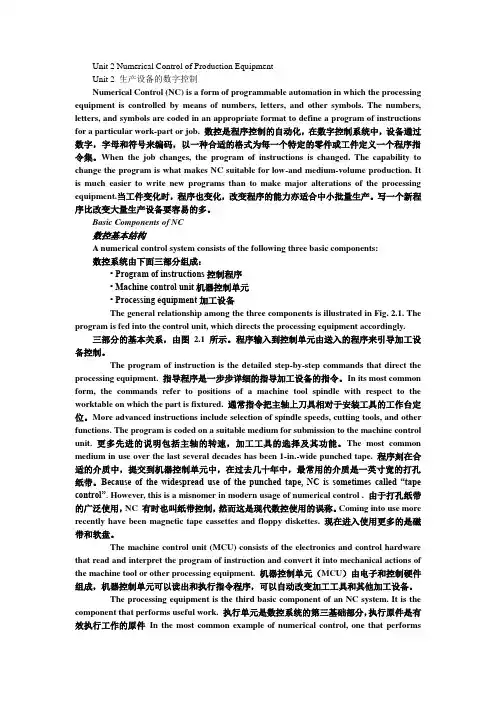
Unit 2 Numerical Control of Production EquipmentUnit 2 生产设备的数字控制Numerical Control (NC) is a form of programmable automation in which the processing equipment is controlled by means of numbers, letters, and other symbols. The numbers, letters, and symbols are coded in an appropriate format to define a program of instructions for a particular work-part or job. 数控是程序控制的自动化,在数字控制系统中,设备通过数字,字母和符号来编码,以一种合适的格式为每一个特定的零件或工件定义一个程序指令集。
When the job changes, the program of instructions is changed. The capability to change the program is what makes NC suitable for low-and medium-volume production. It is much easier to write new programs than to make major alterations of the processing equipment.当工件变化时,程序也变化,改变程序的能力亦适合中小批量生产。
写一个新程序比改变大量生产设备要容易的多。
Basic Components of NC数控基本结构A numerical control system consists of the following three basic components:数控系统由下面三部分组成:• Program of instructions控制程序• Machine control unit机器控制单元• Processing equipment加工设备The general relationship among the three components is illustrated in Fig. 2.1. The program is fed into the control unit, which directs the processing equipment accordingly.三部分的基本关系,由图 2.1 所示。
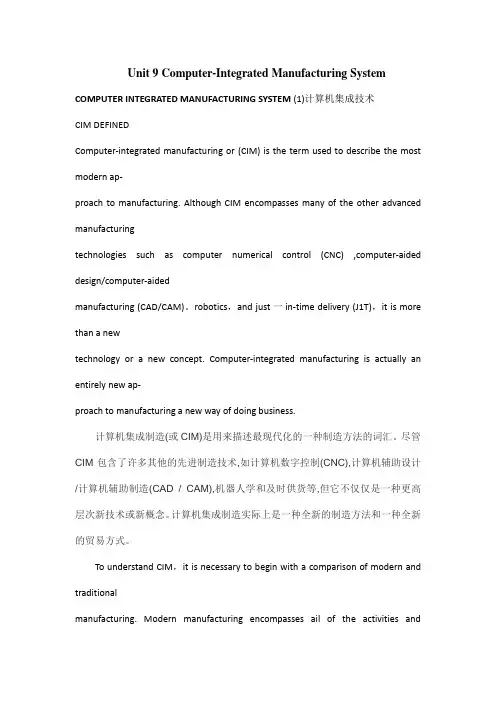
Unit 9 Computer-Integrated Manufacturing System COMPUTER INTEGRATED MANUFACTURING SYSTEM (1)计算机集成技术CIM DEFINEDComputer-integrated manufacturing or (CIM) is the term used to describe the most modern ap-proach to manufacturing. Although CIM encompasses many of the other advanced manufacturingtechnologies such as computer numerical control (CNC) ,computer-aided design/computer-aidedmanufacturing (CAD/CAM)。
robotics,and just一in-time delivery (J1T),it is more than a newtechnology or a new concept. Computer-integrated manufacturing is actually an entirely new ap-proach to manufacturing a new way of doing business.计算机集成制造(或CIM)是用来描述最现代化的一种制造方法的词汇。
尽管CIM包含了许多其他的先进制造技术,如计算机数字控制(CNC),计算机辅助设计/计算机辅助制造(CAD / CAM),机器人学和及时供货等,但它不仅仅是一种更高层次新技术或新概念。
计算机集成制造实际上是一种全新的制造方法和一种全新的贸易方式。
To understand CIM,it is necessary to begin with a comparison of modern and traditionalmanufacturing. Modern manufacturing encompasses ail of the activities andprocesses necessary to convert raw materials into finished products, deliver them to the market,and support them in thefield'. These activities include the following为了理解CIM,有必要一开始就有一个现代和传统制造业的比较。
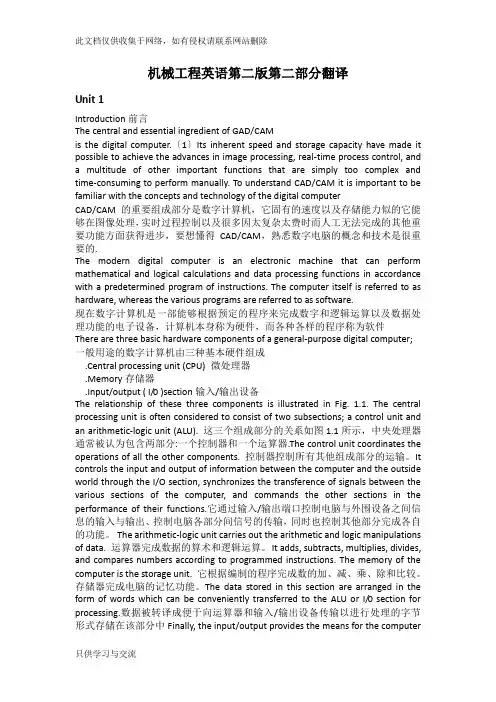
机械工程英语第二版第二部分翻译Unit 1Introduction前言The central and essential ingredient of GAD/CAMis the digital computer.〔1〕Its inherent speed and storage capacity have made it possible to achieve the advances in image processing, real-time process control, and a multitude of other important functions that are simply too complex and time-consuming to perform manually. To understand CAD/CAM it is important to be familiar with the concepts and technology of the digital computerCAD/CAM的重要组成部分是数字计算机,它固有的速度以及存储能力似的它能够在图像处理,实时过程控制以及很多因太复杂太费时而人工无法完成的其他重要功能方面获得进步,要想懂得CAD/CAM,熟悉数字电脑的概念和技术是很重要的.The modern digital computer is an electronic machine that can perform mathematical and logical calculations and data processing functions in accordance with a predetermined program of instructions. The computer itself is referred to as hardware, whereas the various programs are referred to as software.现在数字计算机是一部能够根据预定的程序来完成数字和逻辑运算以及数据处理功能的电子设备,计算机本身称为硬件,而各种各样的程序称为软件There are three basic hardware components of a general-purpose digital computer; 一般用途的数字计算机由三种基本硬件组成.Central processing unit (CPU) 微处理器.Memory存储器.Input/output ( I/0 )section输入/输出设备The relationship of these three components is illustrated in Fig. 1.1. The central processing unit is often considered to consist of two subsections; a control unit and an arithmetic-logic unit (ALU). 这三个组成部分的关系如图1.1所示,中央处理器通常被认为包含两部分:一个控制器和一个运算器.The control unit coordinates the operations of all the other components. 控制器控制所有其他组成部分的运输。
机械工程英语》PART2Unit11中央控制单元(CPU的功能是控制所有系统部件的运行和对数据进行数字的或是逻辑的操作。
为了完成上述功能,CP由以下两个单元组成2.控制单元3..数字逻辑单元3控制单元通过程序指令来协调大量的特种操作,这些操作包括接受输入计算机的数据,并决定和是以何种方法来处理这些数据。
控制单元能指挥数字逻辑单元的操作,他把数据发送给ALL来告诉ALUM据这些数据该运行什么功能,并且在哪里把结果存储下来。
控制单元完成上述操作的能力基于其安装了一个具有储存与记忆功能的总控程序机构。
4数字逻辑单元运行诸如加减比较之类的操作。
这些操作是根据数据以二进制的形式表现出来的。
在指示了确定的条件下,逻辑部也可以用来改变命令执行的次序。
此外,逻辑部分还具有编辑或清除数据等功能。
5控制单元和数字逻辑单元都是得用寄存器来完成他们的功能的,计算机寄存器是一个可以接收短暂存储,转移数据的小记忆装置。
根据计算机能力的不同,寄存器能建立出相应的字节数的字长。
每个词的字节数从4到64不等!PART2U nit2生产设备的数字控制(1)数控是程序控制的自动化,在数字控制系统中,设备通过数字,字母和符号来编码,以一种合适的格式为每一个特定的零件或工件定义一个程序指令集。
当工件变化时,程序也变化,改变程序的能力也就是适合中小批量生产。
写一个新程序比改变大量生产设备要容易的多。
(2)基本结构:数控系统由下面三部分组成: 1.控制程序;2.机器控制单元;3. 加工设备。
三部分的基本关系,由图 2.1 所示。
程序输入到控制单元由送入的程序来引导加工设备控制。
(3)指导程序是一步步详细的指导加工设备的指令。
通常指令把主轴上刀具相对于安装工具的工作台定位。
更多先进的说明包括主轴的转速,加工工具的选择及其功能。
程序刻在合适的介质中,提交到机器控制单元中,在过去几十年中,最常用的介质是一英寸宽的打孔纸带。
由于打孔纸带的广泛使用,N(有时也叫纸带控制,然而这是现代数控使用的误称。
Unit 1 计算机技术1、The central and essential ingredient of GAD/CAM is the digital computer. CAD/CAM的核心部分是数字计算机。
2、Sinfnal conditioners,which filter random electrical noise and smooth the signal emanating from transducting devices.信号调整器,它可以过滤掉杂乱的电噪声,并可修整、平滑由传感装置送出的模拟信号。
3、A pulse counter is used to convert the pulse trains into a digital representation ,which is then aplied to the computer”s input channel. 脉冲计数器可将脉冲串转换为一种数字代码,以适合于计算机输入通道。
4、This results from the shared nature of the communication lines.这来自通信线的共享特性。
5、messages to a specific computer are usually transmitted to all computers in the network,with the addressee decoding its address and accdot the information.送往某特定计算机的信息,一般都传送到网络中的所有计算机,同时由信息接收计算机译出地址码并接收信息。
6、In a network,all computers are connected and communicated with each other according to some kinds of enacthed regulations or agreement,which are called"network protocols".在网络中,所有计算机都根据一些规则和协议进行连接和通信,规则和协议称为网络协议。
机械工程英语第2版叶邦彦Unit2Unit 2 Heat Treatment of Metals What is heat treatment ?Iron-Carbon Diagram AnalysisHeat Treatment TechniquesWhat is heat treatment ?The understanding of heat treatment is embraced by the broader study of metallurgy. Metallurgy is the physics, chemistry, and engineering related to metals from ore extraction to the final product.Heat treatment is the operation of heating and cooling a metal in its solid state to change its physical properties. According to the procedure used, steel can be hardened to resist cutting action and abrasion, or it can be softened to permit machining.Heat Treatment ApplicationMay remove internal stressesMay reduce grain sizeMay increase toughnessMay produce a hard surface on a ductile interiorThe analysis of the steel must be known because small percentages of certain elements, notably carbon, greatly affect the physical properties.Alloy steels owe their properties to the presence of one or more elements other than carbon, namely nickel, chromium , manganese, molybdenum , tungsten, silicon, vanadium , and copper.[1] Because of their improved physical properties they are used commercially in many ways not possible with carbon steels.Iron-Carbon Diagram AnalysisThose portions of the iron-carbon diagram near thedelta region and those above 2% carbon content are of little importance to the engineer and are deleted.[2] A simplified diagram, such as Fig.2.1, focuses on theeutectoid region and is quite useful in understanding the properties and processing of steel.The key transition described in this diagram is the decomposition of single-phase austenite (Y) to the two-phase ferrite plus carbide structure as temperature drops.Control of this reaction, which arises due to the drastically different carbon solubility of austenite and ferrite, enables a wide range of properties to be achieved through heat treatment .The transition processAt the upper temperatures, only austenite is present, the 0.77% carbon being dissolved in solid solution with the iron. When the steel cools to 727℃(1341℉), several changes occur simultaneously . The iron wants to change from the fcc austenite structure to the bcc ferrite structure, but the ferrite can only contain 0.02% carbon in solid solution. [3]The rejected carbonforms the carbon-richcementite intermetallicwith composition Fe3C.In essence, the netreaction at the eutectoidaustenite :0.77%Cferrite:0.02%Ccementite:6.67%CFig.2.1 Simplified ion-carbon diagramSince this chemical separation of the carbon component occurs entirely in the solid state, the resulting structure is a fine mechanical mixture of ferrite and cementite. Specimens prepared by polishing and etching in a weak solution of nitric acid and alcohol reveal the lamellar structure of alternating plates that forms on slow cooling.Heat Treatment Techniques HardeningTemperingAnnealingNormalizingSpheroidizingSurface HardeningHardeningDefinition:Hardening is the process of heating a piece of steel to a temperature within or above its critical range and then cooling it rapidly.Influencing factors:1.the correct temperature is obtained.2.the rate of heating is important.3.The hardness obtained from a given treatment dependson the quenching rate, the carbon content, and work size.TemperingSteel that has been hardened by rapid quenching is brittle and not suitable for most uses. By tempering or drawing, the hardness and brittleness may be reduced to the desired point forservice conditions. As these properties are reduced there is also a decrease in tensile strength and an increase in the ductility and toughness of the steel.The operation consists of reheating quench-hardened steel to some temperature below the critical range followed by any rate of cooling. The final structure obtained from tempering fully hardened steel is called tempered martensite.Tempering is possible because of the instability of the martensite, the principal constituent of hardened steel. Low-temperature draws from 300℉to 400℉(150℃~205℃), do not cause much decrease in hardness and are used principally to relieve internal strains.AnnealingThe primary purpose of annealing is to soften hard steelso that it may be machined or cold worked. This is usually accomplished by heating the steel too slightly above the critical temperature, holding it there until the temperatureof the piece is uniform throughout, and then cooling at a slowly controlled rate so that the temperature of the surface and that of the center of the piece are approximately the same.Annealing effectswipes out all trace of previous structure;refines the crystalline structure;softens the metal;relieves internal stresses previously set up in the metal.The temperature to which given steel should be heated in annealing depends on its composition; for carbon steels it can beobtained readily from the partial iron-iron carbide equilibrium diagram. The heating rate should be consistent with the size and uniformity of sections, so that the entire part is brought up to temperature as uniformly as possible.NormalizingThe process of normalizing consists of heating the steel about 50℉to 100℉(10℃~40℃) above the upper critical range and cooling in still air to room temperature. This process is principally used with low-and medium-carbon steels as well as alloy steels to make the grain structure more uniform, to relieve internal stresses, or to achieve desired results in physical properties.SpheroidizingSpheroidizing is the process of producing astructure in which the cementite is in a spheroidal distribution. If steel is heated slowly to a temperature just below the critical range and held there for a prolonged period of time, this structure will be obtained.Methods Of Surface HardeningCarburizingCarbonitridingCyaniding [氰化]Nitriding [渗氮]CarburizingThe oldest known method of producing a hard surface on steel is case hardening or carburizing. Iron at temperatures close to and above its critical temperature has an affinity for carbon.Thecarbon is absorbed into the metal to form a solid solution with iron and converts the outer surface into high-carbon steel.Pack carburizing consists of placing the parts to be treated in a closed container with some carbonaceous material such as charcoal or coke.。
《机械专业外语》课程教学大纲课程类别:专业选修课适用专业:机械制造与自动化适用层次:高起专适用教育形式:成人教育考核形式:考查所属学院:制造科学与工程学院先修课程:机械设计基础、机械制造基础、工程材料等一、课程简介本课程是机械设计制造及其自动化专业本科生开设的专业选修课。
本课程兼顾英语语言的学习、应用和机械设计制造及其自动化专业知识三个方面的知识。
旨在培养学生在机械设计制造实践中应用英语的能力,同时强化学生对机械设计制造及其自动化专业术语、基本概念和理论的掌握。
内容包括机械设计,加工方法,工程材料和先进制造技术等,涉及面广,专业性强。
二、课程学习目标本课程为以提高学生机械类专业英语阅读和翻译能力为主要目标。
通过本课程的学习,使学生显著提高学生阅读原文专业书刊和翻译国外设备技术文件的能力,同时巩固和加深已有专业知识,了解本学科的发展前沿及国外本学科领域的发展趋势。
(一)知识目标1)使学生掌握机电专业领域的一些常用词汇、词组和特殊句型结构;2)使学生了解专业英语的特点及语法结构特点;3)掌握基本的英语语法规则,并能运用所学的语法知识;4)使学生掌握专业英语的翻译技巧,能基本学会涉及专业业务的结构简单的日常语言的翻译。
(二)能力目标1)使学生理解阅读相关专业一般难度英文材料的能力;2)具有进行简单的专业英语交流的能力;3)使学生借助词典能够阅读本专业领域中等难度的英语文章;4)翻译英文文章的能力;5)拓展学生运用英语进行交际的范围和继续学习的能力。
(三)素质目标1)使学生在学习过程中增进对国外机电专业知识的了解;激发学生的学习兴趣;发展学生的智力,提高他们的观察、注意、记忆、思维、想象、联想等能力;2)通过知识教学的过程培养学生自学能力;3)培养学生的创新精神和实践能力,努力为学生的终身发展奠定语言基础和专业基础;4)培养学生善于沟通交流和团队协助的能力。
三、与其他课程的关系本课程是学生在完成公共英语学习基础上的英语继续学习,学习了机械设计基础、机械制造技术基础、工程材料等专业课基础上开设的一门专业课,具备一定专业知识后在学习该课程能够使学生比较容易接受,教学环节顺序进行。
机械工程专业英语第二版必考翻译(完整版)1.With low-power machinery or vehicles the operator can usually apply sufficient force through a simple mechanical linkage from the pedle or handle to the stationary part of the brake. In many cases, however, this force must be multiplied by using an elaborate braking system.(P5)用低能机器或传力工具,操作者通过向踏板或把手的一个简单机械连接构件作用足够的力量到车闸固定的部分。
大多数情况,然而,用一个详细(复杂)的车闸系统使这个力量成倍增加。
2. The fundamental principle involved is the use of pressed air acting through a piston in a cylinder to set block brakes on the wheels. The action is simultaneous on the wheels of all the cars in the train. The pressed air is carried through a strong hose from car to car with couplings between cars; its release to all the separate block brake units, at the same time, is controlled by the engineer. (Braking Systems)(P5)相关的基本原理是使用压缩气体,通过气缸内的活塞将闸块压在车轮起作用。
Types of Materi als材料的类型Materials may be grouped in several ways. Scientists often classify materials by their state: solid, liqui d, or gas. They also separate them into organic (once living) and inorganic (never living) materials.材料可以按多种方法分类。
科学家常根据状态将材料分为:固体、液体或气体。
他们也把材料分为有机材料(曾经有生命的)和无机材料(从未有生命的)。
For industrial purposes, materials are divided into engineering materials or nonengineering materials. Engin e ering materials are those used in manufacture and become parts of products.就工业效用而言,材料被分为工程材料和非工程材料。
那些用于加工制造并成为产品组成部分的就是工程材料。
Nonengineering materials are the chemicals, fuels, lubricants, and other materials used in the manufacturing proce s s, which do not become part of the product.非工程材料则是化学品、燃料、润滑剂以及其它用于加工制造过程但不成为产品组成部分的材料。